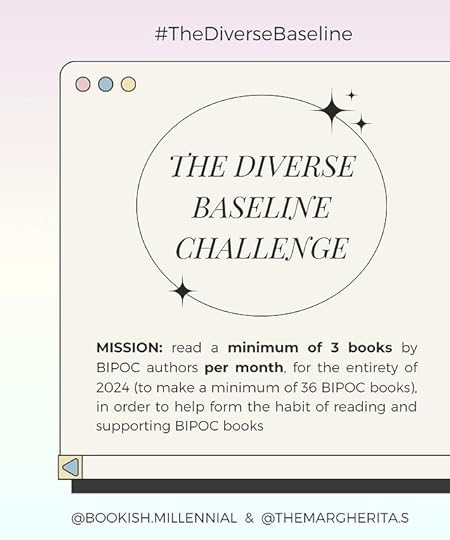Leonor Soliz's Blog
February 22, 2025
Sports romance: Why I’m writing about American Football
This year, I’m working on a new book series that is all about sports romance: the Seattle Strike Series. Not just any sports, but American Football. I want to tell you more about what drew me into this world, and what you can expect from my new series.
First, let’s rewind a little. Romance has been my love ever since I can remember. Every time I became a fan of a book or a TV show, the romantic side plot was my favorite part. But I didn’t read my first proper romance book until my mid-20s: Jewels of the Sun by Nora Roberts. It blew my mind to learn a genre existed where the whole point was to witness people falling love, with a Happily Ever After guaranteed.
Do you want to hear what book first got me into sports romance? It was a few years after that, when I dived into the world of romance books. One of the first ones I devoured at the time was The Wall of Winnipeg and Me by Mariana Zapata. This was my first encounter with this sub-genre and I’ve been a convert since!
All the best tropes come out to playSports romance is fertile ground for my most beloved narratives. One of these is the Found Family trope. I’m a sucker for stories that include it! In this romance niche, characters find their chosen family in the team and the relationships born within it. Players challenge each other as much as they support one another, and I’m here to see it.
What makes writing in this world so appealing is that you can fit it a variety of other tropes. I can write Friends to Lovers as much as Roommates to Lovers or a Workplace Romance, because it all fits within the realm of sports. At the same time, love stories set in this domain allow me to explore non-romantic fantasies that fascinate me. For example, I can write about fame, or being so good at something that you’re well known for your skills.
In the case of American Football in particular, I love the idea of exploring fandom as well. I know what it’s like to be a fan of books and TV shows: a fan’s devotion is both alluring and familiar to me. But that’s not the only reason I picked this sport in particular.
Why I’m writing about American FootballA few things led me to choose the NFL world for the Seattle Strike Series. Some of them are legitimate… and some of them are much more basic, not going to lie!
One of the fun reasons why I’m drawn to this sport is because I can actually have it playing in the background while I write and not get overwhelmed. I generally understand what is happening, and the players draw the eye. Like I had character say in The Game, I personally enjoy the aesthetics of the game. Those uniforms have always been alluring to me!
Mainly, though, I love that the athletes are big and tall. I imagine they could handle a big girl with no issues! This is one of the few sports where we can find plus-size men, and most teams have players of diverse backgrounds. Since I write stories featuring characters of diverse body size and ethnicities who are desired, celebrated and get their happily ever after, all these things about American Football influenced my choice.
Starting my own sports romance seriesEven though I don’t enjoy shipping real life couples, I was one of those people smitten by Travis Kelce’s friendship bracelet Meet Cute idea. Don’t get me wrong, I do not plan to write a story based on his relationship with Taylor Swift. But it did get me thinking of an athlete falling head over heels in love.
Some of it is the nostalgia I feel about reading The Wall of Winnipeg and Me for the first time. As a writer, though, it’s also because I like to spark creativity by changing things up. Starting a new series always brings a breath of fresh air to my writing, and I’m excited for what this new series will do.
With the Seattle Strike Series, I’m writing my favorite things: heroes that fall hard and fast; headstrong heroines; diverse stories and plus-size bodies; found family and cozy feelings. I’ve already fallen in love with these characters and this world, so I can’t wait until you do, too.
The post Sports romance: Why I’m writing about American Football appeared first on Leonor Soliz.
October 22, 2024
My modern Daddy Long Legs retelling
A couple of years ago, I started planning what would become the Cozy Latine Billionaires Series. One of the first decisions I made was to write a modern Daddy Long Legs retelling. In fact, this idea was a primary reason why the leads in the series are billionaires.
Yours, For Good is the last book in the series, and one that has been cooking in my mind for decades. Incredibly difficult to write, too! So let me tell you about the ways in which Jean Webster’s story inspired mine.
A sweet little bookAll throughout my school years back in Chile, we routinely read books assigned by the teacher. Every term, we were tested on our understanding and memory of a novel. That’s how I discovered Daddy Long Legs.
The book tells the story of Jerusha (Judy) Abbott and Jervis Pendleton. Judy is an orphan and Jervis her benefactor, who decides to send Judy to college to get a writing degree. Told almost exclusively through letters, the story shows them falling in love while she completes her studies. It was one of the few books I owned, and I re-read it almost every year.
It’s such a cute story. Judy is hilarious, curious, and has a wonderful joi de vivre. Jervis is a bit of a mystery, as the original story has the limitations of the epistolary medium and Judy’s single POV. Additionally, it has quite the progressive slant, despite its age. It includes a social awareness that has stayed with me through the years. Just like Judy’s happily ever after did.
A modern Daddy Long Legs retelling?Many adaptations have been made of Daddy Long Legs. From anime to a classic Hollywood movie, my favorite is the two-person off-Broadway show with Megan McGinnis and Adam Halpin/Paul Alexander Nolan. I listen to the soundtrack often!
Despite my love for the original story, I recognize its problems. In many ways, Daddy Long Legs is a book that belongs to 1912. Not only is the heroine told what she’ll study, but gender roles are held within patriarchal assumptions. To name one example, a big conflict point comes from Jervis’ expectation that Judy should do as told because she’s a woman and she should listen to older and wiser men.
Of course, she rebels. It’s one of my favorite parts of the book: Judy’s independent spirit. Still, the power dynamics between the main characters aren’t explored. Additionally, when the reveal happens, Judy takes it in stride and it’s decided they will marry.
If you enjoy stories with those dynamics, please read Daddy Long Legs! You might find a new favorite. But I’m not the kind of writer who pens this type of stories. I am the kind of author who takes a beloved book and asks, what would this story be like set in modern times? How might I write such a romance?
Mixing favoritesFortunately, Daddy Long Legs is in the public domain worldwide. This means that I can take Jean Webster’s original and truly use it as a canvas to make it my own. Just like You’ve Got Mail was inspired by The Shop Around The Corner, and paid homage but didn’t create a carbon copy, I also took classic scenes and other Easter eggs to remind us of the inspiration. From names, to locations, to plot points, Yours, For Good brings the essence of Judy’s story with a new viewpoint.
But there is one major difference in my version. I took the opportunity to address a significant issue I have with Daddy Long Legs (and with You’ve Got Mail, for that matter). When Judy learns that Jervis was her benefactor all along, she appears to instantly forgive him. While I didn’t recognize this as a problem as a pre-teen, it doesn’t sit well with me now as an adult.
So I changed it. That plot point reads more like Kat’s reaction to learning about Patrick’s deceit in another favorite of mine, 10 Things I Hate About You. This change is purposeful; my heroines are driven and outspoken, and I don’t see any of them brushing away the hurt someone has caused them. But you’ll have to read to know exactly how this fight turns into a happily ever after…
Javier and Nora, my reimagined Judy and JervisThis book is different from previous stories in the series. While I still aim to write characters who are trying to be good people, and who communicate through the challenges in life, Javier made a huge mistake. Despite his good intentions, he messed up. As a consequence, his story with Nora includes grovel like I haven’t written before.
Additionally, the story starts with letters and with an intention of friendship. These factors result in one of the slowest slow burns I’ve written to date! But if you’re anything like me, this only makes it sweeter when they finally get together.
Yours, For Good includes a tinge of suspense, lots of humor, and what may be one of the most relatable heroines I’ve written to date. There are cameos by everyone in the friend group, and my beta readers appeared to agree this book was a satisfying farewell to the series.
I sincerely hope that Javier and Nora will pull at your heartstrings the same way they pulled at mine. If I did the story justice, then I’m sure it will. It’s the end of an era, after all; my next series will be less of a slow burn and potentially more light-hearted (but with as much romantic tension as I can imbue in them). Let’s give these book friends a sweet farewell together… for now.
The post My modern Daddy Long Legs retelling appeared first on Leonor Soliz.
September 4, 2024
Latine Heritage Month and my romance books
When I wrote about Chilean culture in Yours, Finally, I thought it would be some time before I talked about Latine identity in my romance books again. Since my next planned novels won’t include main characters who are Chilean, I didn’t think that part of my identity would feature quite as heavily in my mind. But I forgot that September 15th is the start to Latine Heritage Month in North America!
As I started seeing content popping up about it, I was inspired to revisit my identity as Latina, my history, and how this will show up in my books moving forward.
Reclaiming my Latine heritageEven though I was born in Latin America, I haven’t always felt Latina. In Chile, we rarely thought about Latin America as a whole, except to discuss which countries we liked or disliked. “Oh, these countries hate us because of the war. This one is a good friend. That other one is fill in the blanks.” We can talk extensively about prejudice and xenophobia in this view, but the bottom line is: I didn’t think of Latinidad as a unifying identity.
That was until I immigrated to Canada. Once I got here, I was told who I was in wholly new ways. I’ve had people complain that my name doesn’t end in an ‘a’ as they think it should, or comment on how impressed they are with my English. They have replaced multiple parts of my identity and culture with Mexican. Not to say anything of how often I need to remind people that if you go south enough, things get cold again…
It was through this process that I reclaimed my Latine heritage. There are parts of who I am that are inextricably connected to the place that birthed me. The people I grew up with, and what I learned about family. Telenovelas and food, and the investment in social relationships. It’s all in a million little details that I don’t always see, until they’re missing. I find my Latinidad in the contrast!
People treat me a certain way because of who they think I am. When I call myself Latina, I’m making a claim: I have an identity. I don’t always have the energy to educate people on what that means to me, or to explain their misconceptions or the systemic barriers that I face. Still, having this one-word label helps me remember an important part of who I am.
Latine culture is difficult to define as a whole. We’re not a monolith! Latin America is a huge geopolitical area with a complex history and ethnicity. Still, I believe there’s one major thing that unites us: how the Global North sees us.
Honoring my roots through my booksPart of reclaiming Latinidad is owning how this culture has helped shape us. What are the parts of it that make our heart sing? How do we want to show up in the spaces we share?
One of the things I like to honor is my Indigenous ancestry. I was raised to believe I didn’t have any Indigenous ancestors (a very common experience in LatAm), so I’m not connected to my indigeneity or know to what Indigenous groups I am connected to, but it’s a part of me that matters. I am mestiza, and Indigenous ancestors survive through me. They were not erased.
Pieces of my process of discovering and reclaiming my Latine heritage have made it into my books. Often, it shows in the different levels of Latine identity my characters hold, or in how much of their world we see their ethnicity. Characters like Ana in Seeking Stars or Eva in Yours, Forever don’t think much about their roots in Latin America. At the same time, characters like Javier and Nora in Yours, Finally have had to actively reclaim what Latinidad means to them.
When I write my Latine characters, I “Frankenstein” who they are based on a few different elements. This includes the pieces of me I give them, like Lina’s experience with a machista uncle in Yours, For Now, or how Max in Yours, Forever misses celebrating Dieciocho back in Chile.
Celebrating Latine Heritage MonthWhile living in North America, I’ve begun to celebrate Latine Heritage Month. As an author on social media, this is the time where I focus extra hard on Latine content. I’ll post within this theme, as well as repost content from Latine accounts: readers, authors, and others.
This year, I will also share more posts more about my Cozy Latine Billionaire series. These four books are my love letter to my culture. One year ago, I published my first Latine couple: Gabe & Lina. You’ll hear more about them, to celebrate the anniversary of their book as well as to prepare for the release of their audiobook (!!!). And… why not stretch things until November, with the release of Yours, For Good? This will be the end of the series, and a nice way to wrap up the year.
As for my private life, I plan to celebrate by meeting with my Latine friends, speak in Spanish at my normal speed (fast), and eat delicious food!
The post Latine Heritage Month and my romance books appeared first on Leonor Soliz.
July 12, 2024
Chilean culture in my romance book series
In many ways, my ongoing romance book series, Cozy Latine Billionaires, is my love letter to Chilean culture. All but one main character is Latine, and the first three books are full of my roots. Now that Yours, Finally (the third book in the series) is here, I want to share the traces of my history that I imbued into Jake and Vi’s story.
Let’s start with one of my favorite traditions.
Once and its foodsI’m pretty sure that I mention once (like the number eleven in Spanish) in every book in the series, and absolutely certain that I mention it in Yours, For Now and Yours, Finally. There is speculation as to why we call this meal this way, the most popular one suggesting it’s a code word for aguardiente, a type of distilled spirit (with eleven letters).
The tradition has changed over the years. Where it used to be a snack, often linked to laborers in colonial times, now it serves as our “tea time” in the evening. In Chile, we don’t usually have dinner. We have once. Bread and things to add to it, like deli meats, cheese, tomato, eggs, or mashed avocado. Something sweet, like kuchen de nuez or manjar, and tea or coffee to accompany it. You can see a collection of once pictures at the Instagram account proyecto.once:
View this post on Instagram
A post shared by Proyecto Once (@proyecto.once)
I’ve always loved the simplicity of it, and the ability to eat intuitively by looking at the table and putting something together that looks appealing and satisfies your cravings. Inviting someone for oncecita (the suffix ito/a in Spanish denotes something small or endearing) is a gesture of affection and friendship, and one I still do with my friends up here in Canada.
Sometimes, for special occasions, we add special treats. Let me tell you more about the ones I mention in Yours, Finally.
LúcumaYou probably don’t know much about this fruit, and I’d like to offer my most sincere condolences because you’re missing out. The lúcuma flavor is unique, and we use it in lots of desserts. The San Francisco ice cream that features the fruit and manjar is simply delicious, and a lúcuma cake is a classic as well.

I’ve tried finding this fruit here in Canada, and I have not been successful. My secret is that I have two frozen packs of lúcuma puré in the basement, which I hope will turn into a dessert one day. Cross your fingers that it won’t be freezer-burnt by the time I convince Mr. Leonor to make me something (he’s the baker in this multi-ethnic household).
While I haven’t had it in years, I imagined the Sotomayors have a way to get it that rich folk have access to and I don’t. But I think it’s still probably hard to find in North America, money privilege or not, which is why the character of Tía Sonia only gets a lúcuma cake for special occasions (as you’d have seen if you’ve already read Yours, Finally!).
HumitasThe Chilean version of tamales doesn’t have anything but mashed sweet corn in it. Sometimes it’s seasoned with a bit of basil. We usually sprinkle sugar on top, or eat it with a tomato salad. In the book, Tía Sonia takes a few out of the freezer for dinner: this is something we all learn to do in the summer. We make about a hundred humitas and freeze most of them, so we can have them throughout the year.

With the influx of German and Swiss immigrants to the south of Chile, we enjoy some of their influence in our national cuisine. Aside from delicious craft beer (my favorite being the Kunstmann Honey or Kunstmann Torobayo – I used to get these all the time back home), kuchen is a staple dessert. Kuchen de nuez, or pecan kuchen, is one of the most popular ones.

In Jake and Vi’s story, I also mention sincronizadas. I learned about this simple dish while in Mexico, and wanted to make room for it. The quesadilla-type dish, with both cheese and deli meat, is so easy to put together. Lina, my MC from Yours, For Now, makes sincronizadas for dinner in Yours, Finally, but adds a tomato salad to the meal. This very simple moment speaks of another of my own experiences as a migrant: when I was chatting about sincronizadas with a close Mexican friend here in my city, she told me people usually eat it with beans or pico de gallo. I jokingly complained it should be eaten with a tomato salad. We bickered about the differences between our cultures and inspiration struck. Now it’s Gabe and Lina who have a small clash over their own cultural differences for dinner!
Tío & TíaThe group of four friends this romance book series is based on call Sonia and Raúl tío and tía to make them happy. While these terms refer to uncles and aunts in Spanish, in Chile we use it for friends’ parents quite liberally. We may in fact use it for any adult who is a caregiver in some capacity, or sometimes even as a sign of respect for an older person. In my books, it’s a sign of affection for Raúl and Sonia, and it’s a reminder of their own culture. Gabe’s best friends use the titles just to please them.
Huaso/a dressJake has been symbolically adopted by the Sotomayors since he was a child, and so he’s done many things out of a sense of gratitude and deference to the family. One of these is learning Spanish, and learning about Chilean culture. It’s because of it that he mentions the traditional masc clothing for huasos.
Huasos are Chile’s country folk, and usually skilled horse riders. They are related to the Chilean subculture around cattle farming and large pieces of land; they also relate to the cueca dance, which I mention in Yours, Forever.

I have a few pictures pinned for this traditional attire in my Pinterest board for Jake and Vi!
Final wordsI’m not sure how much of my culture will go into my next few books. Even though my heroines will always be Latine (and curvy!), the books I have planned for the next year and a half do not have Chilean main characters.
Of course, I will continue to incorporate details I’ve experienced, researched, or learned about my Latine ethnicity at large; there are things that unite us as Latin American peoples. Despite the unifying characteristics, granularity exists and those details that are common to the Chilean culture may not show up as clearly in the future. Even so, I’m thrilled I’ve been able to share so much with you through this romance book series!
The post Chilean culture in my romance book series appeared first on Leonor Soliz.
April 29, 2024
Celebrating Fat Joy: Plus-size characters in romance books
Seeing plus-size characters in romance books is a matter close to my heart. Every book I’ve written has a curvy FMC! Admittedly, I can’t say that of my MMCs — they exist in different parts of the spectrum, from sculpted, muscular Liam in Seeking Stars, to Gabe, a man with “love handles”, in Yours, For Now.
As I wrote Jake in Yours, Finally, my first proper plus-size MMC, I revisited the purposefulness with which I include fat bodies in my romance books. If art, writing, and reading are political, how are curvy characters part of that?
First, we need to talk about fat-phobia. Even as a thin child, I was put on diets (as young as 10 years old!). By the time I was 16, my environment made sure I knew I was fat. I learned that I should feel shame about it, and work hard to not be my size anymore. I constantly hear that my body is wrong, whether from people in my every day life, the media, or the medical system.
This isn’t a unique experience. Regardless of the size of your body, chances are that you’re aware of many of the beliefs pushed onto us about fat people. Even if you are in a smaller body, it’s possible you don’t feel like it. That’s the extent to which anti-fat bias exists in the world; it’s pervasive, oppressive, and difficult to eradicate. As Sabrina Strings explains in her book Fearing The Black Body, racism, anti-fat oppression, and other forms of discrimination intertwine in culture.
Fortunately, I’ve been in the fat-liberationist space for many years, and have been able to deconstruct many of these beliefs. This is why I look at my role as an author, as a person in this space, and as a reader through this lens.
The body in the romance genreEvery time I read or write a book, I pay attention to body descriptions. Does the text tell us the characters’ skin color, or are we to assume that they’re white unless otherwise stated? Do we get descriptors to indicate whether we have thin or fat main characters? When a writer describes bodies, how do they do so? Are bodies’ characteristics gendered? What kind of characters carry fat? (Hopefully not only the villains and those used for comic relief!)
I know most people don’t move through the world using this filter. Within the romance genre, we often hear that readers just want to escape reality. In my opinion, the assumption that entertainment and rest exist only if we shut down our social awareness comes from privilege and a lack of nuanced understanding. Even more so, I think active engagement with the media we consume is one of our responsibilities as world citizens. Inspecting the way we address issues in books helps us take a step forward to making the world a better place.
This means paying attention to the stories we craft and read. Recognizing fat-phobic or other discriminatory themes in books requires awareness, and learning to recognize violent language. If we don’t, we internalize it. Books and other media help shape our reality, and so the bodies we describe and celebrate matter.
In the romance genre, we’re actively determining who gets a Happily Ever After — I believe everyone should get theirs. To make that happen, we need stories with diverse characters. But we will only have more of those if we actively seek them.
Writing plus-size characters in romanceWhen we make fat characters the main focus of romance books, we’re doing something revolutionary. Diet culture and fat-phobia dictate that large bodies should be hidden and shamed. If we want to flip that script in stories with a Happily Ever After, we have to do it purposefully.
One way to highlight plus-size bodies in books is by including them in covers. Often, stock photography is sorely lacking in curvy bodies. This is even worse if we’re looking for large bodies with intersecting identities, like racialized fat bodies, or large bodies using mobility aids. Illustrated covers are often not much better. It’s rare to see book covers that clearly show the curves and shadows of a soft body. Because of this, making a point of seeking visual representations of plus-size characters for book covers is a good place to start.
Another way to show larger bodies on page is by using the right descriptors: words like round, soft, plush, ample, and so many others. Not only that, but we can recount how a fat body moves in the world. From the difficulty of finding nice clothes to chairs with armrests that dig into your hips, existing in a larger body means particular experiences in life.
Celebrating Fat JoyPeople in larger bodies have complex lives, like everybody else. In this sense, stories that include plus size characters can take any tone. They can be happy or sad, be contemporary or belong in fantasy, and feature characters with multiple intersections.
As a romance author, I write stories that help me visualize the world I want. With that intention in mind, my books include fat neutrality and fat joy. I write heroes who enjoy seeing the way their heroine’s bodies jiggle, heroines that have no self-criticism, and I use unbiased terms to describe bodies.
In Yours, Finally (Book 3 of my Cozy Latine Billionaires series), Jake and Vi fall in love because of who they are as a whole, not because or despite the bodies they have. There’s comfort and pleasure in who they are with each other.
As a writer, writing fat bodies this way warms my heart. My goal is that people reading my stories will see what it’s like to live our best life as larger people, and getting our own Happily Ever After. Just like my characters, I feel the joy, too.
The post Celebrating Fat Joy: Plus-size characters in romance books appeared first on Leonor Soliz.
February 26, 2024
Chilean inspiration in my romance books: Yours, Forever
When Yours, For Now released in September 2023, I made a tour guide post to the book. It included information on the Sotomayor family, characters, food, and drinks that made an appearance in the story. I’m a Chilean immigrant in Canada, and I’ve spent significant time with Latine folks from other countries. That’s why there’s a lot of Chilean inspiration in my romance books, and why it’s important to me to reflect the diversity of Latin America, its peoples, and their cultures, as much as I can.
Now, with the release of Yours, Forever, I want to share with you a whole new layer of Chilean culture that features in this marriage of convenience romance! Another tour guide, if you will. Ready to learn more?
Dieciocho and its traditionsI believe that my identities help shape my stories. Part of my Chilean identity is el Dieciocho: September the Eighteenth. While it’s technically about celebrating Chile’s independence, it’s really a four-to-ten day long opportunity to get together with family and friends. During that time, we celebrate our culture; like one of my character says in Yours, Forever, cueca plays everywhere. September is a windy month, as Winter gives way to Spring, and kites and the Chilean flag look amazing in the breeze. Empanadas, asados, wine, chicha, and more are celebrated every day. In this new book in the Cozy Latine Billionaire Series, you will find more about…
CuecaEvery September, schools have student shows where children learn and practice different traditional dances, including cueca. They all have specific music associated with them. In the case of cueca in particular, which is the national dance, it tells the story of how a rooster seduces a hen. It also has a few variations depending on the area it comes from in the country.
An example of the danceA video about some of the traditions
In Yours, Forever, the characters discuss how the whole dance is about flirting, and the slow burn between two people who want to be together. In there, I included a joke about myself. Because sometimes I wonder if I would be so into slow burns and tension if it weren’t embedded in my culture!
AsadoEven though barbeque is the most common meal of the Dieciocho, it is something we do from September to March. Sometimes, we even do it during winter. If it’s not raining, that’s enough for us!
Asado itself is an event that goes for hours. Poor Mr. Leonor went through cultural shock when confronted to a meal that lasts from 2 pm to midnight, give or take a few hours. Many bottles of wine are consumed; sometimes, chicha or terremoto are offered, as well as beer. For the children, pop is common.
Asado al palo (bbq on a stick), more typical in the South of Chile
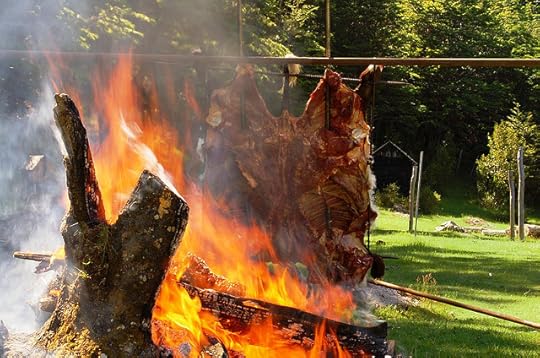
See the people sitting around, chatting, eating, playing? This is asado 💜
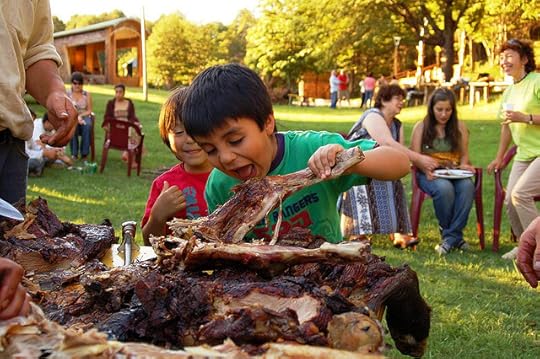
Typical cuts of beef, pork, sausages, and bread that you might find at an asado.
The red sausage is a longaniza, and I’ll tell you more about it below.
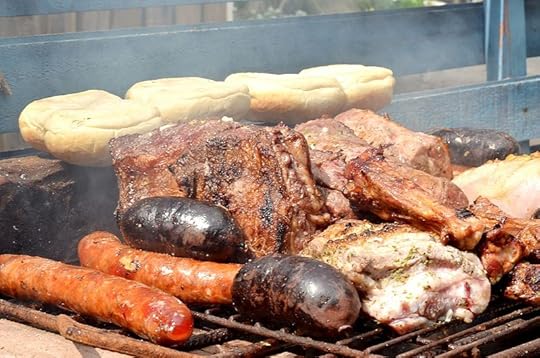
The meal starts with picoteo, or finger foods. Chips are available, with mayo, mashed palta (avocado), or pebre to dip in. Choripán and grilled hot dogs cut into thirds are also typically available, as well as empanadas. After many rounds of that, the main meal is ready, with big pieces of beef, pork, or chicken plus salads (to make it a “light” main dish LOL).
No wonder it takes many hours, and a certain training, to know how to pace yourself and eat together with family and friends!
Choripán y PebreA typical starter for asados is choripán. It’s often spiced up with mayo and/or pebre. As there is a special mention of choripán in Yours, Forever, let’s dive a little deeper.
Marraqueta
This form of Chilean bread is one of my favorite. SO good, and intrinsic to choripán.
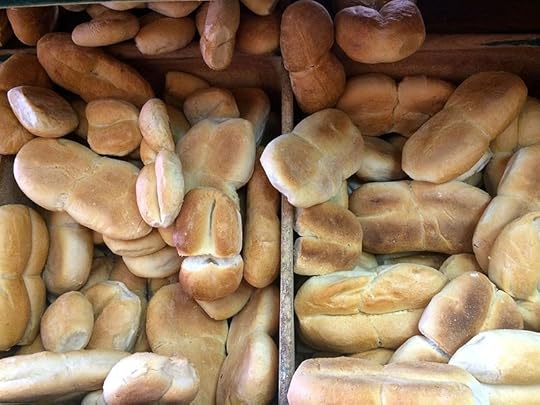
Pebre
Many recipes exist; each family has their own version. It typically consists of onion, tomato, lots of cilantro, an acid (lemon juice or vinegar), garlic, a vegetal oil, salt, pepper, and sometimes some spicy pepper chopped very small.
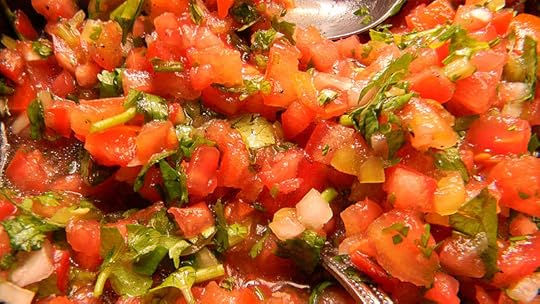
Choripán
Longaniza stuffed in a piece of Marraqueta. In this picture, you can see a choripán with pebre (and you can see the many salads of an asado in the background)
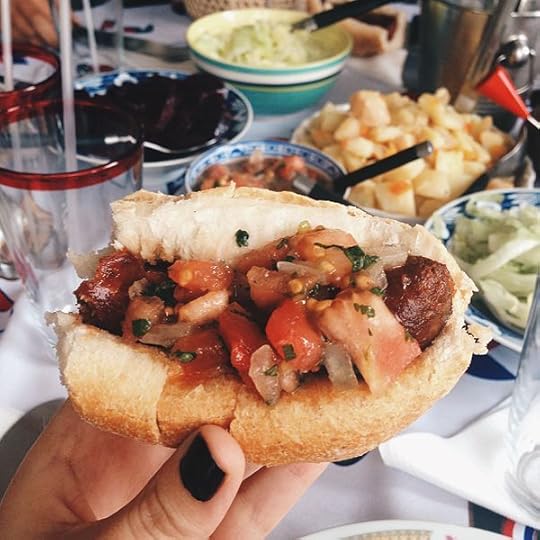
If my father knew about my author career, I would ask his permission to share the family pebre recipe. As it is, I hope you feel adventurous and experiment with it sometime! And keep in mind the longaniza, as there is a joke that Max makes about it that is so typically Chilean, it hurts.
Other FoodsBesides Dieciocho and its traditions, a few other Chilean foods and drinks make it into Yours, Forever.
AraucanoView this post on Instagram
A post shared by Radio Alcaldía Ciudadana (@radioalcaldiaciudadana)
I will admit I hadn’t looked into the history of this liquor, and now I wonder about appropriation of the Mapuche culture. It’s purported to have included indigenous pharmacology knowledge, but I doubt indigenous folk benefit in any way. After a quick search online, I couldn’t find anything at this time. Unfortunately, I am currently disconnected from my indigenous ancestry. Based on what I know of my family history, I wonder if I have Mapuche ancestors. I wish I could ask them about it!
I do miss this liquor, though. I’d like to figure out the ethics of consuming this drink, because I would love to have it again.
Calzones RotosFried dough, where you make a hole in the middle and twist one end through to create a knot. Literal translation: broken/torn undies (!). Powdered sugar is sprinkled on top.
We eat calzones rotos with tea, especially on cold days, generally in the late afternoon.
 Chorrillana
ChorrillanaThis bar food is a shareable meal. See the three forks digging in? There are a few versions of it, but the base is this: a bed of fries, with or without sausage or chopped hot dogs, fried or caramelized onions, thin slices of meat, and sometimes a fried egg on top.
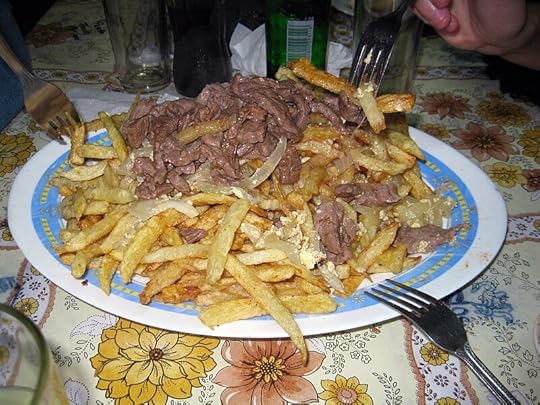 Sobremesa
SobremesaApparently, this is a word and tradition we inherited from Spanish colonialism. It’s also one of my favorite memories from being together with people.
It consists on prolonging the time at the table after a meal. It’s a relaxing and connecting time, where there may be dessert and hot drinks like coffee, teas, and other infusions; or liquors, digestifs, or other alcoholic drinks. It can last for several hours.
Final wordsIt’s incredible to think that, after two books and two posts about my culture, there is so much left unsaid. When I was eighteen and did an international exchange program, they taught us that cultures are like icebergs: you can only see so much on the surface. Most of it will remain hidden underwater. Now as an immigrant, this is knowledge that I carry with me every day.
I will never be able to fully express the range of experiences that someone from Chile might identify with. Even now, I can think of several tidbits of culture I have yet to mention. The thing is, describing an ethnicity or culture will always fail under a microscope. The more you look into how an individual experiences their intersections, the more you will find granularity and differences. Meanwhile, if you zoom out and look at humanity as a whole, you will find common experiences.
My books are a vehicle of cultural exploration. Different pieces will show up with each story. My next book, Yours, Finally includes my final Chilean character. I wonder what parts of my culture will show up through it! My hope is that, as a whole, you will get to visit parts of my history with me.
The post Chilean inspiration in my romance books: Yours, Forever appeared first on Leonor Soliz.
January 2, 2024
Is reading diversely one of your 2024 goals? (It should!)
Happy New Year, everyone! I can almost feel the excitement in the air during January, wafting from every person motivated to make this year the one they achieve their resolutions. In bookish spaces, those resolutions include how many or which books people are going to read that year. Will they read 50 books or 100? Will they read the popular book with the dragons, or the hyped celebrity memoir? But what I’m really wondering is how intentional our reading goals are. For example, is reading diversely on your bucket list for 2024? Because I think it should be! Let’s see what it looks like to be purposeful in our reading habits.
Do you feel good about your bookish goals?As a writer who discusses politics and policies almost every day in my day job, I’ve learned that self-awareness and agency go hand in hand. We need to know why we do the things we do, and decide if that’s how we want to keep going. That is why, for instance, I believe that the romance books we choose to read are both political expression and action. Whether that choice is conscious or passive, it still has consequences in the world. One example is that, by continuing to favor the same authors, it gives publishers the feedback, “I’m good with things just as they are, I don’t need to give other kinds of books a chance.”
Often in bookish spaces, well-meaning folks promise they will be reading diversely moving forward, after something big happens out in the world: Black Lives Matter, Asian hatred, genocide in the Middle East, appalling Goodreads Awards… But what ends up happening is that those diverse books get added to people’s TBR lists, and that’s where they stay. Clearly, it’s not enough to have good values and intention! What books are you actually reading?
You can assume you’re acting in alignment with your values if you feel good about the books you read in 2023. Of course, this only tells you if you like what is happening; it doesn’t mean your actions have no impacts in the world. If you don’t value diversity, for example, you will feel good about picking up whatever books look interesting, no second thoughts about it.
If you’re reading this blog post, I assume you value diversity. Do you feel good about how you’re interacting with content creators in bookish spaces? With the books you’re choosing to read?
Pick books outside your comfort zone!An interesting question to ask ourselves is: do we care about growth? This is a topic where we can often check both our values and our perception of agency. We may value growth but, if we think that we don’t have the power to change things, we become passive. On the other hand, if we care about self-improvement and believe in our agency, we know we have choices. So, maybe we feel good about our reading behaviors! But if we truly care about growth and our values, we may choose to take a step further and pick books outside our comfort zone that are aligned with those goals.
One of my favorite creators, Sarah (@sarah_thebookishnerd on Instagram and TikTok), keeps careful stats that I love to spy on. She recently posted about how she plans to expand the diverse books she reads. Additionally, I’ve been keeping an eye on the Diverse Baseline Challenge, ran by Margherita (@themargherita.s) and Brittany (@bookish.millennial).
Keeping stats and joining challenges is one way to hold ourselves accountable to our reading goals!
Reading diversely is a choiceIf you discover that your values and your actions don’t align, don’t let it discourage you. Change what you’re doing! Pay attention to how you interact with content online, as algorithms favor those who already have a big platform. If you want to make sure you find the right content, look up hashtags and follow diverse creators. It’s a great way to not only find books you wouldn’t have come across otherwise, but also to normalize a diverse feed. It also helps change the algorithms themselves, as who you follow and how you interact with accounts online feed back into the system.
Another way to be purposeful is to pay attention to the books to see if you’re currently reading diversely. Do you read a mix of indie and traditionally published? Is the cast of your books diverse? Were the main characters written by authors of similar intersections to them? Are the authors from different backgrounds and identities than yours?
As a writer, I pay attention to these things in how I craft my books. It’s my belief that every writer should. Not only in terms of the stories we tell, but how we move in social spaces as well. In fact, every single actor in the publishing industry has responsibility in shaping bookish spaces. I encourage you to look at your own spaces and find the ways in which you will impact them.
The post Is reading diversely one of your 2024 goals? (It should!) appeared first on Leonor Soliz.
November 20, 2023
Why I view romance books as political action
I used to say I didn’t believe in politics. This was mostly out of cynicism and disempowerment. I thought there was nothing I could do to change those in power or how they ruled my country. My views have changed significantly in the past 10 years: now, I believe everything is political. I don’t know if I would see the world through an intersectional, political lens if I hadn’t had the opportunity to work with the people I did at the right time. This shaped me and how I move through the world today, which includes the stories that I write. With my knowledge and experiences, I couldn’t not consider how the choices I made were political. In fact, I had to be purposeful about how politics and romance books intersect. This is why I view romance books as political action, and why I believe that politics belong in reader spaces.
The myth of apoliticismI’ve come to think of three possible causes for my former so-called apoliticism. The first one is internalized -isms and phobias. Even though I was poor on and off growing up, I believed that, with hard work, I could make as much money as I needed. I also missed how other identities and intersections would affect me. For example: the privilege I had as a light-skinned mestiza or in my last name, and the discrimination I faced when I became fat as a teenager, but that I thought I deserved because it was something I needed to fix. By being constantly exposed to misguided, discriminatory, and prejudiced ideas, we tend to internalize them as true and their consequences as deserved. One of the places in which we consume ideas is through books. In that sense, books are a vehicle to learn about the world and its rules.
The second cause is privilege. After immigration, I learned through lived experience why identifying as apolitical was a reflection of my privilege and internalized patriarchy, capitalism, fatphobia, racism, and colonialism. If we’re not directly affected by the injustices of the world, they may be invisible to us. We may not be aware of our and other people’s suffering after looking away for so long. It is a privilege to have the space and opportunity to disengage from injustice, and it takes intentionality to re-engage. Thinking of books as an escape is creating distance from how powerful they can be, the messages they relay, and how they affect the global consciousness.
The final cause is disempowerment: even someone who is aware of social inequality may see themselves as apolitical. One of the reasons for this may be that they don’t believe they have the power to create change. In fact, hopelessness is a weapon that keeps us stagnant. Why would I ever act, if I believed it would lead to nothing in the best of circumstances? In cases like these, we may see books as simple entertainment, and a way to gain relief from hopelessness.
Romance books as political expressionI write characters that live in very similar intersections to mine. Some of them are Latine, some of them are in bicultural relationships, all my MFCs have fat in their bodies and some of my MMCs do too. Some of my characters are immigrants, and one of my MFCs is Bi. My existence as someone living with intersections is political, and so is writing characters like that. They tell stories of people not usually portrayed in media. Since books appear to aid in the development of empathy, they have the potential to expand our understanding of ourselves and the world.
However, I also write books that imagine a world where people like me and my characters have great things happen to them. They’re privileged; they get access to wealth. I imagine what a world with more social justice might look like and help create a vision for what is possible for us and others with marginalized identities. This is political, too. It can point us in the right direction, while soothing our heart. Comfort is both a privilege and an act of rebellion against a world where hopelessness is convenient for those who prefer the status quo.
Bookish spaces and politicsCommunication theory says that it’s impossible not to communicate. Even when trying to say or show nothing, we’re communicating something. The same is true about politics. Looking away from an issue allows it to continue as is. Escape through books means disconnecting from reality, which not everyone can do. Would they burn and ban books if they didn’t hold power?
All books communicate something about their authors and the world at the time in which they were written. Now, if every act is political, readers’ behaviors will impact the world as well. The books a reader chooses to engage with is a political act. How people approach the reading process is a political act. Choosing to read books like mine, in a world that favors books without a diverse cast, can in itself be a political act.
Books can provide rest, comfort, relief, and even an escape, as long as we’re purposeful. Self-nourishment and joy are a necessary part of rebellion; all we need to do is remember to come back to the promotion of social justice. Intentionality is crucial to engage with our agency. If we don’t, at what point are we giving away our agency to affect change in our surroundings?
We need to remember that every (in)action holds power. Politics are the place where our power and agency interact with how we run and organize our communities. Books can be a vehicle to multiple aspects of this interaction with the world. As a romance reader and author, I invite us to think critically about how we create or consume content in bookish spaces. How are we using our power to create change?
The post Why I view romance books as political action appeared first on Leonor Soliz.
September 22, 2023
How my identities shape my books
As a native Chilean, September has always been a special month for me: we celebrate El Dieciocho, our Independence holiday, and welcome Spring. Since moving to North America, though, September has never felt the same. Being an immigrant means you’re never home again. But this has also helped me discover other identities in me, all of which have shaped my books.
In this post, I wanted to sit with my nostalgia and explore how things have changed. There are multiple ways in which I’ve incorporated these themes into my stories. Let me show you a bit of this journey!
El Dieciocho: Chile’s Independence DayOne of my earliest memories is of my family travelling to spend El Dieciocho, the independence holidays, with my grandparents in the countryside. This is also when Winter gives way to Spring, and the temperatures are absolutely perfect: sunny, with a cool breeze, and a balmy 23ºC inviting us to spend time outside again. In a way, it’s like Chileans thaw in September.
Once upon a time, Chile used to celebrate its independence from Spain on February 12th and September 18th. The former date is the actual date Chile declared its independence, while the latter is when the first national government took shape. Legend says that Chileans partied hard for both dates, and the government later decided to pack it all into one celebration. In part, that may be why the country celebrates so hard in September—we’re making up for the February party that was taken from us!
In any case, the date helped name the celebration: dieciocho means eighteen. If you go to Chile and ask, “what are you doing for the eighteenth?”, everyone will understand what you mean. The 19th is a national holiday as well, and the days before and after these two days are very low productivity times. Everyone is thinking and preparing for partying! Depending on the day of the week it falls on, this could mean a whole week of celebration.
The way we celebrate is unique to the season. El Dieciocho is so important, it’s probably the second most celebrated holiday of the year. Chile’s “patriotic partying” has a defined brand. Everything is decorated in blue, red, and white; cueca plays everywhere; and everyone gets together for barbecue with family and friends. Wine and chicha are everywhere. Or terremotos, if you’re brave! This goes on for the whole month, but specially over the days surrounding the 18th.
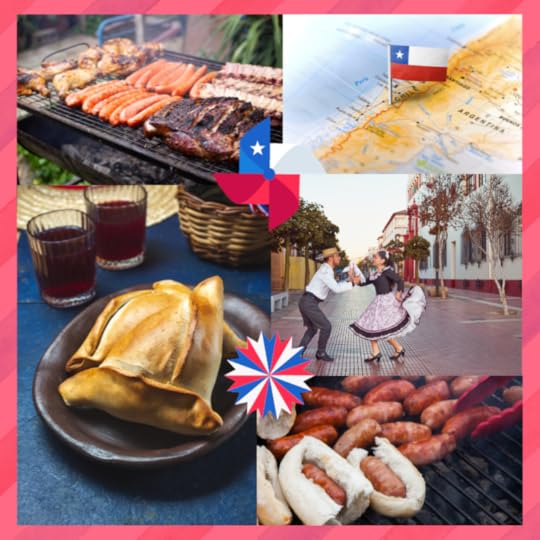
I moved to Canada more than ten years ago. At first, I’d feel sad every September. Where were the flags, decoration, and music? The Chilean food I can get here doesn’t taste exactly like back home. Now, with some time gone by, I still look back and miss it, but I’ve accepted it. I know that, if I ever get a chance to visit Chile again, I will do my best to go in September. I will also keep looking for food alternatives in Canada, as I haven’t given up hope yet.
Over the years, I found different ways to celebrate this part of my identity as an expat. My writing has become the perfect sandbox to revisit my favourite memories. It’s special to me that my first Chilean hero debuted in September. Gabe in Yours, For Now, as well as his family and one of his best friends, are Chilean. Like I shared in my Guide Into Yours, For Now post, the book includes multiple nods to the Chilean food I miss.
Being an author gives me the freedom to choose just how far to take it so, in my next book, Yours, Forever, the Sotomayors will invite Max to the lake house for a proper Dieciocho gathering. I can’t wait to share that!
My new identities and my writingWhile everyone’s self-perception can shift over time, a change as significant as migration is bound to intensify the process. My relationship to Chile has changed, as well as my identity as Latina. Now the month of September means something else to me, thanks to Latine Heritage Month (September 15th to October 15th in the USA, and the whole of October in Canada). This matters because, ever since moving here, my understanding of what it means to be Latine has grown much more complex.
After moving to Canada, I learned to expect being racialized. People tend to assume my country’s culture and weather is the same as Mexico. Or that I grew up listening to salsa and reguetón. I’ve also experienced multiple levels of microaggressions. On the other hand, I’m aware that I miss a culture that has moved on; Chile isn’t the same country I lived in through my 20s. All of this helps shape my new understanding. If I hadn’t left Chile, I would have never truly identified with being a racialized Latina woman.
This self exploration has lead to other identity shifts as well. I will never know what this journey would have been like if I had stayed in Chile, but coming to terms with my queerness has been something I’ve dedicated time to while in Canada. Coincidentally, Bisexuality Awareness Week is celebrated in September as well, from the 16th to the 23rd. And, just like with Gabe and his nationality, the fact that my first bisexual heroine made her debut this month is special to me.
Lina’s story has a lot of my story. I used her book as a sandbox to bring in my identities and feelings. Her queerness is just part of her life and identity; Yours, For Now isn’t a story about her being bisexual. She happens to be bisexual, like I do. She can be attracted to all genders, though she fell in love with a man… like it happened for me. She’s not out to her family for the same reasons I’m not.
Vulnerability and booksI don’t often put so much of me in my characters, but Yours, For Now is a clear exception. When I wrote this story, I worried about how it would be received. Tío Miguel is based on an uncle of mine; I cried writing Edgardo’s letter because I wish I heard some of those words myself. I used to be someone who toughened up to survive in that environment. The earthquake analogy Gabe shares with Lina? I use it in my day job all the time!
I think that’s why this book felt so vulnerable—because it has so much of me. I’ve always written parts of my identity, like fatness and latinidad, as I know them. But making the Sotomayors Chilean, and Lina carry some of my old wounds and many of my identities felt different.
Something tells me that, while September used to be about Chile’s Independence and coming together for me, now it’s going to be all about identity. Both of those meanings are about closeness, and that’s the kind of warmth I wish readers will find in the stories I share.
The post How my identities shape my books appeared first on Leonor Soliz.
August 26, 2023
Yours, For Now: Notes on food, language, and family
I’ve written in the past about how to represent Latinamerican culture in books. It still rings true, to think about the diversity within the ethnicity, and acknowledge it as a complex thing. There are many ways to be Latine, and all have room in romance books.
That is why I included lots of references to Latinamerican foods, dynamics, and my first language. My good friend and beta reader C, who is from a different ethnicity, said she loved it. I loved that! And she also said she would have loved to know what the foods I mentioned are from my perspective. Another comment was that even though she’s used to large family dynamics, she got a bit lost with the big name dump in this book. LOL! So for C and for any readers who might appreciate the aid, I wanted to put everything together for you to peruse.
Let me take you on a tour of Yours, For Now.
FamilyA big theme in the Cozy Latine Billionaires series is found family. The Sotomayors are a welcoming, warm Chilean family who emigrated to North America. You’re welcome to imagine whether that’s the US or Canada! Gabriel, the oldest Sotomayor child, has three best friends who were emotionally adopted by his parents. Violeta, aka Vi (Vee), is the younger Sotomayor child and gets her own story as well.
As a therapist by day, I sometimes use a tool called genogram. These diagrams can get quite complex, but I made a simplified version to show the families discussed in the book and some basic dynamics:
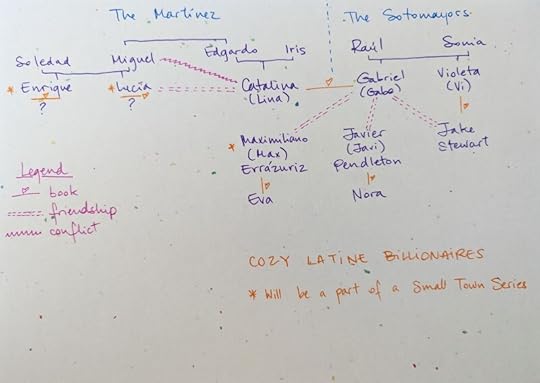
The key point of this genogram is to show that, through the romantic relationship between Gabe and Lina, the Martínez and the Sotomayors get linked. The conflict between Miguel and Lina is a big catalyst for the book; in fact, it is the main reason Gabe and Lina end up in a fake dating relationship.
The relationship between Max, Javier, Jake, and each of their parents, is complicated. They all found a family with the Sotomayors, and the series is about how each of them find their person.
I hope this genogram helps you locate each person in relation to each other.
Food & DrinksSince Mr. Leonor edits my books, he gets to read them before anyone else. During his first read of Yours, For Now, Mr. Leonor said, “wow, everyone’s drinking coffee all the time.”
Yes. Yes, they are.
Even though that’s not the case for all of Latinamerica of course, it definitely was my experience. It was either coffee or tea, but everyone drinks something, often not pure water. One drink I mention in the book is Pisco Sour.
Pisco Sour (Chile)Chile and Perú have a long history of… debate… over which country came up with Pisco, and I will not go there on this blog.
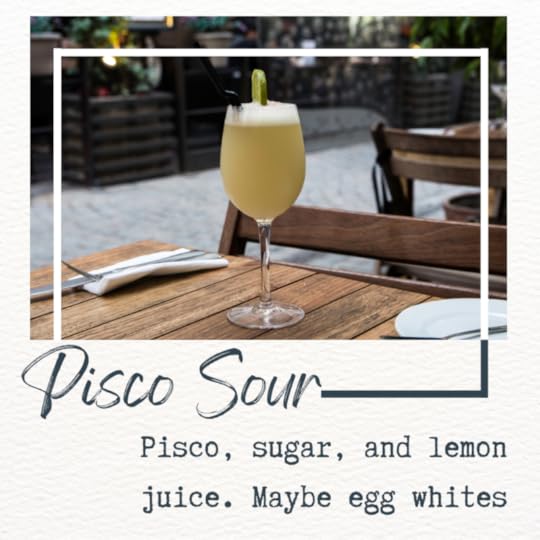
It is typically consumed as a pre-meal drink, especially for late lunch. It can be home made or store bought.
Hojarascas (Mexico)While these are usually Christmas cookies in parts of Mexico, they’re so good that I just wanted them in the story somewhere.
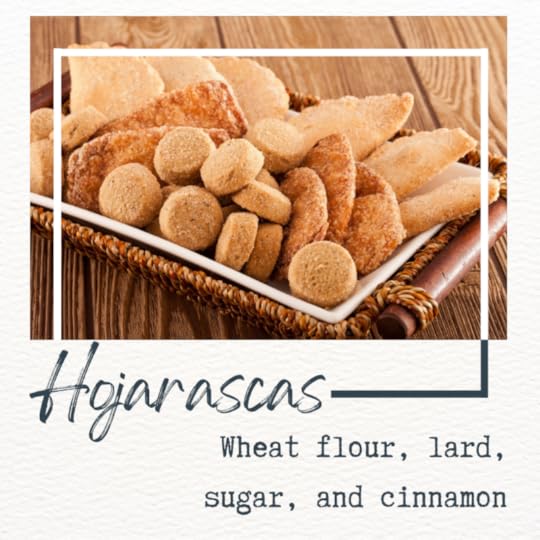
Yum! This is a classic soup-like dish. There is some flexibility in the ingredients; but the most typical ones are as follows:
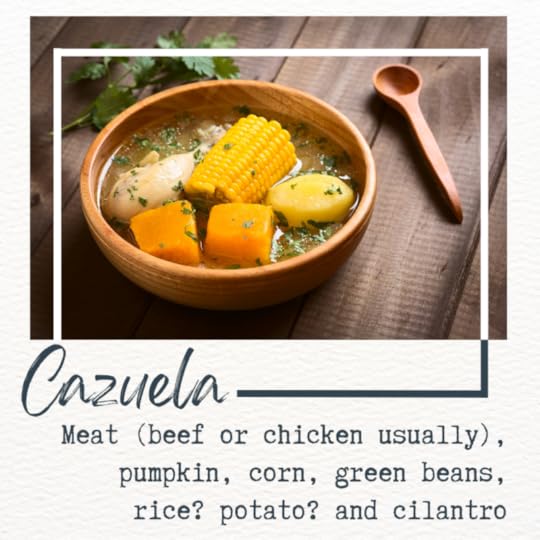
The pumpkin we use, Zapallo Camote, is a little bit like the Halloween pumpkin but with a grey-green skin. The cilantro is sprinkled on top right before eating, directly onto your plate. A bit of rice is optional. Cooked slowly for the best flavor!
Frijoles Charros (Mexico)I’ve been fortunate enough to spend a lot of time in Mexico. One of my absolute favorite dishes is this one.
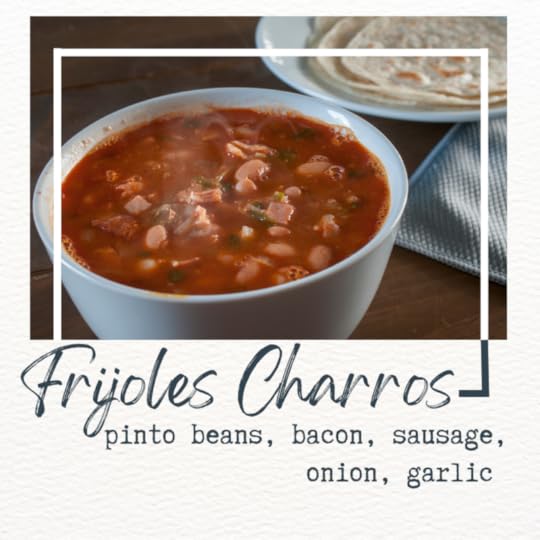
It’s so tasty and filling! I should try to make it at home.
Charquicán (Chile)This is a staple meal at my house. Both Mr. Leonor and I love this dish!
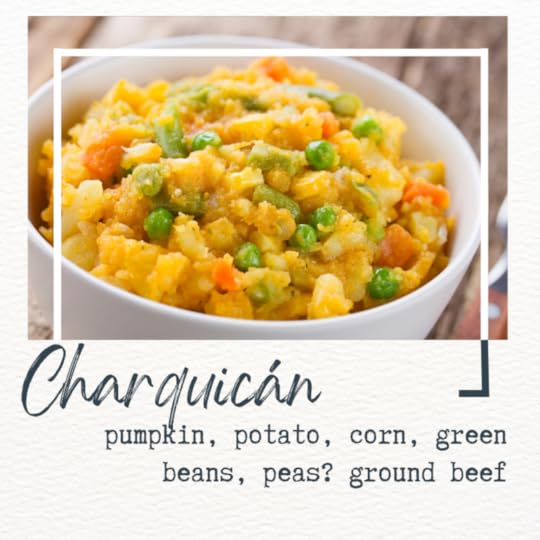
This is another dish with flexibility. I sometimes use finely chopped bok choi or spinach instead of green beans, for example. Also, traditionally, people would add a fried egg or a longaniza on top (chilean version of chorizo).
Arroz Primavera (Chile)Again, a staple dish in my home, and one with flexibility!
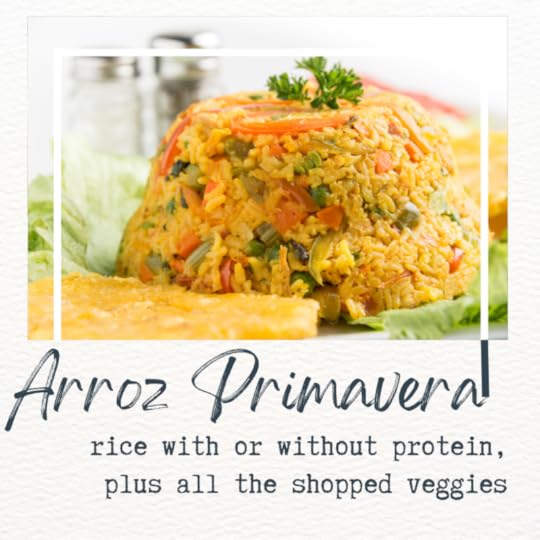
While the rice is the base starch, it’s supposed to be mixed with multiple chopped veggies. Some of the most common ones are celery, carrot, onion, corn, peas, tomatoes… As for protein, the most common ones are ground beef or tuna. If the protein isn’t in the rice, it would go on the side and it could be any kind.
Alfajores (Chile)Now back to the sweets. There are a few versions of this dessert, they’re all filled with manjar (the name we give in Chile to dulce de leche). I picked the most popular one for the picture.
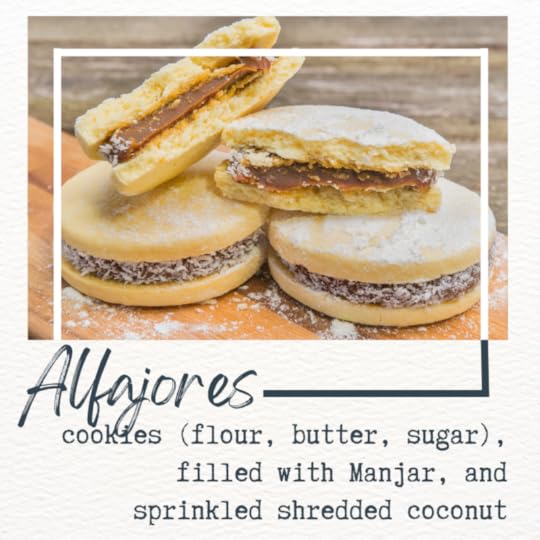
If you want to get fancy, instead of sprinkling them with shredded coconut, you can cover them in chocolate. They’re even better that way, in my opinion!
Pastel de Choclo (Chile)I left one of my favorite dishes for last. This one takes a long time to make, so we usually reserve it for special occasions.
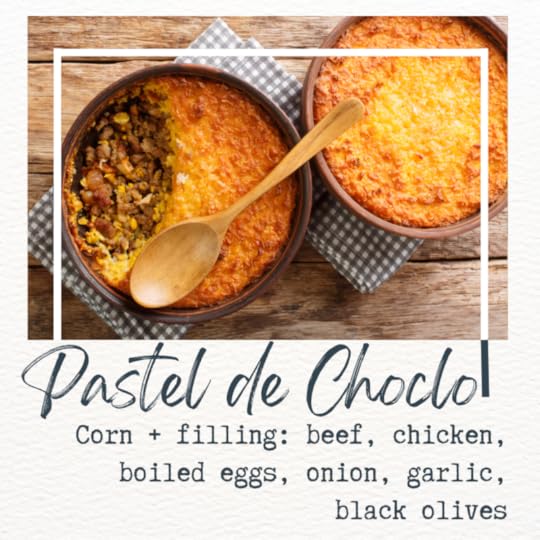
Imagine a sort of shepard’s pie, but using mashed corn instead of potatoes. The corn mix is usually spiced with basil, while the filling is spiced with cumin and other classics. Sugar is sprinkled on top and then it’s broiled, so it caramelizes. It’s a dish for the summer and joy!
CultureWhile in Chile we don’t use hot spices very much, we do use lots of spices. Some of the most used ones are cumin, garlic and onion of course, cilantro seeds, black pepper, and paprika. Another thing I’d like you to know, is that having a salad as a part of the meal is a Very Important Detail! Tomato salad, lettuce, cauliflower salad, broccoli salad… almost any veggie can be made into a salad, and we only use oil, salt, and an acid (vinegar or lemon) to dress it up.
Even writing this post, I find myself linking these foods to culture. When in Mexico or back home in Chile, these dishes were intrinsic to my experiences. Yours, For Now is full of the culture I grew up with, so of course I had to talk about the food that reminds me of home.
This book has the most of me I’ve written to date. Both in terms of who Catalina had to be to withstand the sharp edges of her family’s beliefs, to the food and culture that shaped her story with Gabe. I welcome you to it, and I hope you feel at home.
The post Yours, For Now: Notes on food, language, and family appeared first on Leonor Soliz.

